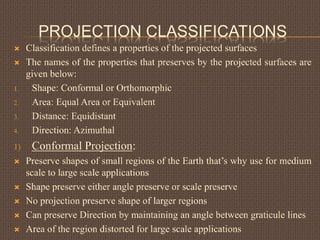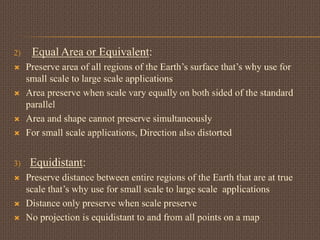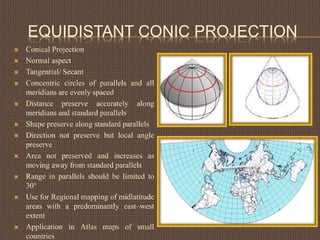GIS Map Projection
- 1. GIS MAP PROJECTIONS Muhammd Bilal Saleem Session 2012-2014 M.Phil Geomatics
- 2. DESCRIPTION Two dimensional representation of the three dimensional Earth Systematic transformation of latitudes and longitudes to parallels and meridians respectively An intriguing component of the coordinate system referencing because it portrays high level of flexibility Transformation cause distortion in real world properties that are: 1. Shape 2. Area 3. Distance 4. Direction
- 3. DEVELOPABLE PROJECTION SURFACES Determine specific method of physical projection Three kinds of developable projection surfaces: 1. Cone 2. Cylinder 3. Plane The name of the projections made from these surface are: 1. Conic Projection 2. Cylindrical Projection 3. Planar Projection
- 4. 1. Conic Projection: Conic projection is fan shaped, characterized by an upside down cone over the sphere Conic projection are at an true scale along a standard parallel/s between the equator and a pole Conic projections are used for midlatitude zones that have an east– west orientation If equally space, distance preserve If distance between parallels increase near border, shape preserve If distance towards north and south pole decreases, area preserve
- 5. 2. Cylindrical Projection: Cylindrical projection is a rectangular grid representation, characterized by a cylinder over a sphere Cylindrical projections are at an true scale along a central meridian/s and standard parallel/s near a equator Cylindrical projection mostly use for tropical zones All cylindrical projections are equidistant along central meridian/s and standard parallel/s
- 6. 3. Planar Projection: Planar projection is a circular representation with a focus, characterized by plane over a sphere Planar projection is also called Azimuthal projection or Zenithal projection Planar projections are true only at their focus Planar projections mostly use for polar zones Planar projection more better describe circular regions than rectangular regions
- 7. Azimuthal Projection is further divided into three different projection on the basis of projection focus: 1. Gnomonic/ Central projection 2. Stereographic Projection 3. Orthographic Projection 1) Gnomonic Projection: Azimuthal projection in which projection focus is at center of the Earth
- 8. 2) Stereographic Projection: Azimuthal projection in which projection focus is from pole to pole 3) Orthographic Projection: Azimuthal projection in which projection focus is at infinity
- 9. LOCATION OF DEVELOPABLE PROJECTION SURFACE There are two cases in which developable projection surface meet Earth: 1. Tangent: DPS touches the Earth One standard parallel/ One Central meridian 2. Secant: DPS cuts the Earth Two standard parallels/ Two central meridians
- 10. ASPECT OF DEVELOPABLE PROJECTION SURFACE Projection aspect is the relative orientation of the developable projection surface and Earth with respect to the observer There are four kinds of projection aspects: 1. Normal 2. Transverse 3. Oblique 4. Polar 1) Normal Aspect: Oriented with polar axis Based on parallels Normal aspect is Equatorial aspect if standard parallel is equator Normal aspect is Azimuthal aspect if standard parallel touches poles
- 11. 2) Transverse Aspect: Oriented perpendicular to polar axis Based on meridians 3) Oblique Aspect: Oriented at any angle with polar axis Based on central meridian and standard parallel Use for geographical areas that are centered along lines that are neither parallel nor meridians Directed as northwest, northeast, southwest and southeast
- 12. 4) Polar Aspect: Oriented on focus as north or south pole Based on straight meridians with a concentric parallels Polar aspect only related to planar projection or Azimuthal projection or Zenithal projection
- 13. PROJECTION CLASSIFICATIONS Classification defines a properties of the projected surfaces The names of the properties that preserves by the projected surfaces are given below: 1. Shape: Conformal or Orthomorphic 2. Area: Equal Area or Equivalent 3. Distance: Equidistant 4. Direction: Azimuthal 1) Conformal Projection: Preserve shapes of small regions of the Earth that’s why use for medium scale to large scale applications Shape preserve either angle preserve or scale preserve No projection preserve shape of larger regions Can preserve Direction by maintaining an angle between graticule lines Area of the region distorted for large scale applications
- 14. 2) Equal Area or Equivalent: Preserve area of all regions of the Earth’s surface that’s why use for small scale to large scale applications Area preserve when scale vary equally on both sided of the standard parallel Area and shape cannot preserve simultaneously For small scale applications, Direction also distorted 3) Equidistant: Preserve distance between entire regions of the Earth that are at true scale that’s why use for small scale to large scale applications Distance only preserve when scale preserve No projection is equidistant to and from all points on a map
- 15. 4) Azimuthal: Preserve direction of all regions of the Earth that’s why use for medium to large scale applications Direction preserve when angle preserve Azimuthal projection can be equal area, conformal or equidistant Formation of Map Projections: DPS can exhibit more than one classification The conic projection, cylindrical projection and planar projection can be combined with one or more of the projection classifications to control the appearance and distortion for any particular application There are lot of projections that can made by this procedure. Some of the projections will discussed
- 16. MERCATOR PROJECTION Cylindrical projection Normal aspect Equator/ Two latitudes symmetrical around the equator Meridians are parallel to each other and equally spaced Parallels are parallel but become farther apart toward the poles Distance preserve along Equator or Two latitudes Shape preserve accurately Direction preserve accurately along graticule lines Area not preserved and increase towards the top and bottom of the map Use in Standard sea navigation charts, Wind direction, Air travel and Ocean currents Application in Conformal world maps
- 17. CYLINDRICAL EQUAL AREA PROJECTION Cylindrical projection Equatorial aspect Tangent to the equator All meridians are equally spaced and 0.32 times the length of the equator Parallels are equally spaced and farthest apart near the equator Poles are lines of length equal to the equator Distance preserve along equator Shape not preserve because of scale variation Direction not preserved but local angle preserve along standard parallels Area preserve accurately Use for narrow areas extending along the equatorial regions
- 18. UNIVERSAL TRANSVERSE MERCATOR PROJECTION Cylindrical projection Transverse aspect Two parallel lines spaced from each central meridian by 180 km Earth is divided into 60 zones that are spanning 6⁰ of longitude form 84⁰N & 80⁰S with central meridian of each zone and equator Distance preserve along each central meridian Shape not preserve accurately Direction preserve for each zone Area preserved and minimal distortion along the boundary of zone Extent should be limited to 15⁰-20 ⁰ on both sides of the central meridian Many countries use local UTM zones based on the official geographic coordinate systems in use
- 19. EQUIDISTANT CONIC PROJECTION Conical Projection Normal aspect Tangential/ Secant Concentric circles of parallels and all meridians are evenly spaced Distance preserve accurately along meridians and standard parallels Shape preserve along standard parallels Direction not preserve but local angle preserve Area not preserved and increases as moving away from standard parallels Range in parallels should be limited to 30° Use for Regional mapping of midlatitude areas with a predominantly east–west extent Application in Atlas maps of small countries
- 20. ALBERS EQUAL AREA PROJECTION Conic projection Normal aspect Secant All meridians equally spaced Distance between concentric parallels decreases toward poles Distance preserve for mid latitude Shape not preserve and distortion increases between standard parallels Direction not preserve but local angle preserve Area preserve accurately Used for small countries but not for continents. Used for the conterminous United States
- 21. LAMBERT CONFORMAL CONICAL PROJECTION Conic projection Normal aspect Secant All meridians are equally spaced Distance between arc of parallels increases near a border Distance preserve for mid latitude Shape preserve accurately Direction preserve accurately Area not preserved except small regions near standard parallels All latitudinal range should not exceed 35° Use for regions that have east- west extension
- 22. LAMBERT AZIMUTHAL EQUAL AREA PROJECTION Planar projection Equatorial, polar and oblique aspect Tangent of single pint anywhere Equatorial aspect: The equator Polar aspect: All meridians Oblique aspect: Central meridian Distance preserve only along focus Shape not preserved because of about 2% error within 15° from focus Direction preserve accurately from focus Area preserve accurately Use for Population density, Political boundaries Use in Oceanic mapping for energy, Minerals, Geology, and Tectonics
- 23. Use for displaying entire continents Equatorial aspect: Africa, Southeast Asia, Australia, the Caribbean, and Central America Polar aspect: Polar regions Oblique aspect: North America, Europe, and Asia
- 24. UNIVERSAL POLAR STEREOGRAPHIC PROJECTION Stereographic projection Polar aspect Tangent at pole The focus is either a north pole or south pole to 84° N and 80° S The latitude 81°06'52.3" N or 81°06'52.3" S at true scale and all meridians Distance preserve only at focus and latitude of 81°06'52.3" N or 81°06'52.3" S Shape preserve accurately Direction preserve accurately from focus Area not preserve and increases moving away from focus Use for Conformal mapping of polar regions Use for mapping polar regions of the UTM coordinate system
- 25. OTHERS PROJECTIONS The other projections which are not conceptually made and not easily related to developable projection surface There are three kinds of these projections: 1. Modified projection 2. Pseudo projection 3. Compromise projection 1) Modified Projection: Modified form of conceptual projections to reduce distortion For example, the Space Oblique Mercator projection is a modified form of Mercator projection, Aitoff is a modified form of planar projection etc
- 26. 2) Pseudo Projection: Have some Characteristics of another class of projection For example, the Sinusoidal is called a pseudo cylindrical projection, Bonne is called pseudo conic projection and Werner is called pseudo planar projection etc 3) Compromise Projection: Average or interrupted form of different projection For example, Goode's Homolosine projection is a combination of the Mollweide and sinusoidal projections etc

























